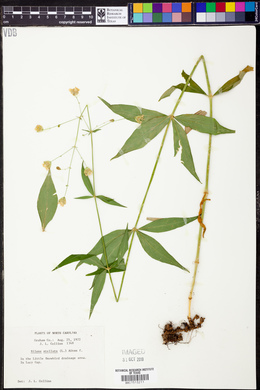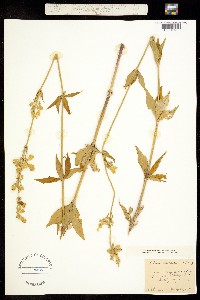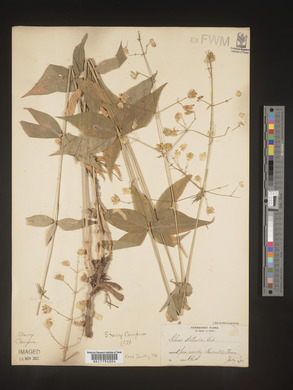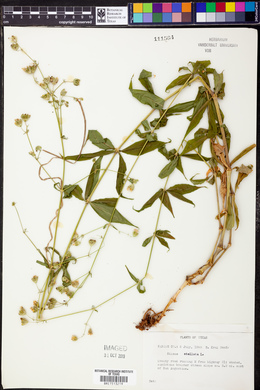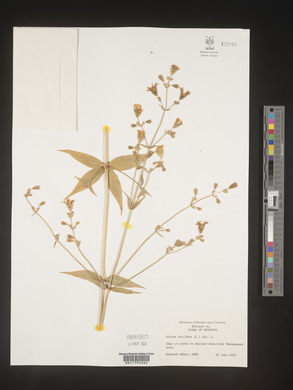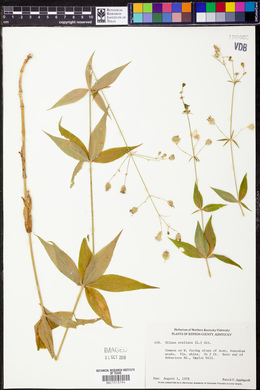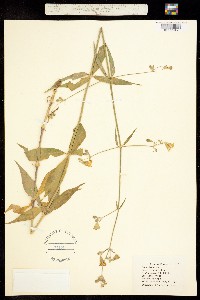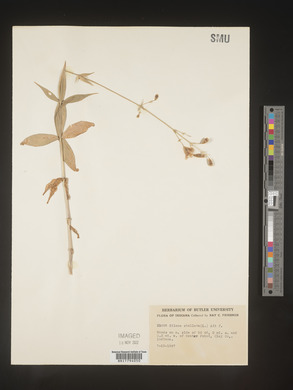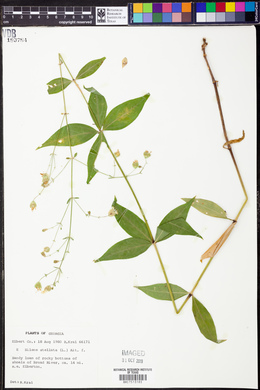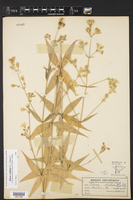Silene stellata
|
|
|
|
Family: Caryophyllaceae
Widow's-Frill, more...starry campion, widow's frill, widowsfrill
[Cucubalus stellatus L., moreLychnis stellata var. scabrella (Nieuwl.) E.J. Palmer & Steyerm., Silene scabrella (Nieuwl.) G.N.Jones, Silene stellata var. scabrella (Nieuwl.) E. J. Palmer & Steyerm.] |
Plants perennial; taproot thick; caudex branched. Stems several, simple proximal to inflorescence, 30-80 cm, puberulent, becoming subglabrous near base. Leaves withering proximally, in whorls of 4, ± sessile to short-petiolate, largest in mid-stem region; blade lanceolate to ovate-lanceolate, 3-10 cm × 4-40 mm, apex acuminate, puberulent on both surfaces, sparsely so adaxially. Inflorescences paniculate, open, bracteate, bracteolate, branches elongate, puberulent; bracts and bracteoles linear-lanceolate, 2-15 mm. Pedicels straight, often with 1 or 2 pairs of bracteoles, slender, 1/ 2-3 times calyx, glabrous or scabrous-puberulous. Flowers: calyx obscurely 10-veined, broadly campanulate, becoming obtriangular in fruit, 7-11 × 6-10 mm, herbaceous, margins dentate, very narrow, membranous, sparsely puberulent, lobes broadly triangular, 2-3 mm; corolla white, ca. 2 times longer than calyx, limb obtriangular, narrowed into claw, divided ca. 1/ 2 its length into 4-12 lobes, appendages absent; stamens equaling petals; styles 3, longer than petals. Capsules globose, opening by 3 broadly triangular teeth; carpophore 2-3 mm. Seeds dark brown, reniform, ca. 1 mm, papillate. 2n = (34), 48. Flowering summer. Rich deciduous woods, river flats, tall-grass prairies; 0-1300 m; Ala., Ark., Conn., Del., D.C., Ga., Ill., Ind., Iowa, Kans., Ky., La., Md., Mich., Minn., Miss., Mo., Nebr., N.J., N.Y., N.C., Ohio, Okla., Pa., R.I., S.C., S.Dak., Tenn., Tex., Vt., Va., W.Va., Wis. Silene stellata is a very distinct species with its broadly lanceolate leaves in groups of four at each node, and its brilliant white, multilobed petals. Two varieties are recognized by some workers: var. stellata, with glabrous pedicels; and var. scabrella, with scabrous pedicels. The former tends to have longer, more slender pedicels and be more common towards the northeast, whereas the latter tends to be more western. The correlation of characters and distribution is poor, however, and intermediate plants are often encountered. Silene stellata was collected near the Grand River, Cambridge, Ontario, in 1941, but was probably introduced there and has not been seen since.
Perennial herb with a thick taproot 30 cm - 0.8 m tall Leaves: in whorls of four, withering at base, more or less stalkless to short-stalked, 3 - 10 cm long, 0.5 - 4 cm wide, largest at middle of stem, lance-shaped to narrowly egg-shaped with a pointed tip, minutely hairy. Inflorescence: an elongate-branched, open cluster (panicle) of flowers, subtended by bracts and bractlets. Flowers: white, two times longer than calyx. Stalk straight, slender, often with one or two pairs of bractlets. Stamens ten, as long as petals. Styles three, longer than petals. Sepals: fused at the base into a tube (calyx). Calyx tube 5 - 12 mm long, 6 - 10 mm wide, broadly bell-shaped, obscurely ten-veined, finely minutely hairy, with five short lobes. Lobes 2 - 3 mm long and broadly triangular. Petals: five, white, 8 - 11 mm long, reverse triangular with a narrowing base, clawed, deeply four- to twelve-lobed, woolly at base. Lobes long and thin. Fruit: a dehiscent capsule, opening by three broadly triangular teeth, spherical. Seeds dark brown, about 1 mm long, kidney-shaped, roughened. Stems: several, unbranched, minutely hairy, nearly hairless near base. Similar species: No information at this time. Flowering: July to early October Habitat and ecology: Frequent in dry open woodlands. Also found in prairie habitats. Occurence in the Chicago region: native Etymology: Silene probably comes from the Greek word sialon, meaning saliva, referring to the sticky secretion on many of these plants. It may also have come from the word seilenos, referable to Silenus-a foam-covered, drunken character in Greek Mythology. Stellata means starry, or "with star-like rays." Author: The Morton Arboretum Perennial with several simple, puberulent stems 3-12 dm; cauline lvs mostly in whorls of 4, lance-linear to lance-ovate, 3-10 cm, to 4 cm wide, acuminate; infl loosely paniculate; cal campanulate, 5-12 mm, finely puberulent; pet white, 8-11 mm, lanate at base, the auricles and appendages none, the blade fimbriately 8-12-lobed; carpophore 2-3 mm; styles 3; capsule dehiscent by 6 teeth; 2n=48. Woods. June-Aug. Var. stellata, with essentially glabrous pedicels and cal, occurs from Conn. to O. and Nebr., s. to Ga. and Tex. Var. scabrella (Nieuwl.) E. J. Palmer & Steyerm., with densely crisp-puberulent pedicels and cal, occurs from O. and Mich. to N.D., s. to Tenn. and Tex. Gleason, Henry A. & Cronquist, Arthur J. 1991. Manual of vascular plants of northeastern United States and adjacent Canada. lxxv + 910 pp. ©The New York Botanical Garden. All rights reserved. Used by permission. From Flora of Indiana (1940) by Charles C. Deam [Deam's treatment includes two varieties: var. stellata has glabrous leaves and stems, while they are pubescent in var. scabrella.] The glabrous form of the species is the southern form and is represented in Indiana by a few specimens from the southern counties. In Sullivan County I found the species and the variety [var. scabrella] growing together. The species, like the variety, grows in dry woodland and is rarely found in clearings and along fences. I have no data concerning its distribution other than that it is known to occur from Pennsylvania and Indiana southward. [The pubescent form is] infrequent to frequent in dry woodland throughout the state. I have no data concerning its distribution. …… Indiana Coefficient of Conservatism: C = 5 Wetland Indicator Status: N/A |
|
|
|










